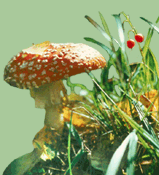The genetic analysis proved the existence of wolf-dog hybrids in Estonia
Maris Hindrikson, Peep Männil and Urmas Saarma describe the wolf-dogs of Estonia and their genetic analysis and elaborate on the accompanying threats on wolf population and people. Wolves and dogs are very closely related and therefore it is quite difficult to differentiate between wolves, dogs and their hybrids and the research means studying a great multitude of genes. Based on the literature, female wolves usually initiate mating involving male dogs. These female wolves are mostly old, sick or isolated from the herd. Wolf-dogs are more common in areas where the wolf population is scattered and the natural structure of the population is damaged. Although, as long as our wolf population is strong enough and open to immigrants, the genesis of hybrids cause no harm to the wolf population. Usually wolf-dogs are no threat to humans, either, because they tend to be timid and non-aggressive.
Horizontal gene transfer
Tanel Tenson introduces an essential evolutionary feature that is especially common among bacteria, but becoming also increasingly known among eucaryotes. We know quite a lot about vertical gene transfer, when genes are inherited from parents to offspring; less is known about horizontal or lateral gene transfer, when genes are transferred from one organism to another, unrelated organism. This type of transfer seems to be common among bacteria and possibly among all procaryotes. Lateral gene transfer has been ascertained from bacteria to eucaryotes. Trans-eucaryotal gene transfer cannot yet be determined, as science still has little tools for that type of research.
Chronics: The world-wide Biology Olympiad among high school students
Estonian Nature enquires
Jaanus Elts updates the finishing of the Bird Atlas.
Annelie Ehlvest writes about an international project involving research of banded snails, to celebrate Charles Darwins 200th anniversary.
The ecology of urban badgers and their conflicts with people
John Davison mediates the experiences of towns of Great Britain in researching badgers living in towns: these badgers live side by side with people, almost like our urban cats. Research has shown that urban badgers are very keen in their main setts, which sometimes have over a hundred inlets and more than a kilometer of tunnels. The outlier setts turned out to be used very little. Urban badgers mostly have a convenient and lazy lifestyle. Living in garden areas, they need a little effort to provide themselves with food. It was interesting to find that urban badgers have little or no territoriality, while rural badgers are often strongly territorial. These and other changes in behavior seem important in adapting to the different environmental conditions of urban areas.
Practical tips: our Amanitas 4
Mall Vaasmas next series of fly mushrooms, furnished with photos by Vello Liiv.
Interview: Our man on the lakes of the Antarctica
Toomas Jüriado has interviewed Enn Kaup, a polar researcher
The Bird of the Year: There are sounds in the night
Mall Hiiemäe reminds her contacts with young tawny owls: their activities have been a source for many horror stories.
Lots of good! The corn campaign in Soviet Estonia
Ken Kalling takes a look at the impacts of Khrushchevs visit to the US 50 years ago: for a while, corn was also grown on the fields of Estonia. The author gives an overview of so-called agribiological sciences that emerged in Soviet Union. It was hoped that corn silage would help to increase cattle herding and therefore decrease the constant food problem in Soviet Union. It was, however, soon realized, that vegetation period in Estonia was too short for successful cultivation of corn. All in all, the corn campaign was much politicized throughout the Soviet period.
Practical tips: How to record the sounds of nature 1
Veljo Runnel introduces the principles of recording the sounds of nature. He introduces different types of recorders and microphones, as well as cables and tripods. There are three main groups of voices prevalent in nature: birds, frogs, and crickets and grasshoppers, which are of interest for recorders.
Get acquainted: Bush-crickets
Veljo Runnel brings examples about insects, which can be recognized based on their sounds. These are bush-crickets whose songs are typical for Estonia summers. Two bush-cricket species present in Estonia are described and pictured.
The sandpiper came and went away, and feathers were left behind
Juhani Püttsepp shares the impressions of himself and Ingmar Muusikus from the encounters of curlew sandpipers on the Austrugrunne Peninsula of the Vormsi Island. A couple of hundred curlew sandpipers were not afraid of people and let them have beautiful close-ups of this migratory species.
|


![[IN ENGLISH]](images/gb.gif)





